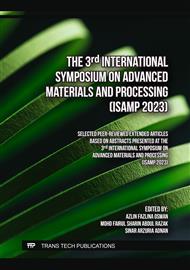[1]
F. Rosner, T. Bhagde, D. S. Slaughter, V. Zorba, and J. Stokes-draut, "Techno-Economic and Carbon Dioxide Emission Assessment of Carbon Black Production," J. Clean. Prod., 436(2024) 140224.
DOI: 10.1016/j.jclepro.2023.140224
Google Scholar
[2]
G. K, Technological Characteristics of Epoxy/Carbon Black Composites, Materials Today: Proceedings. 31 (2020) 496–498.
Google Scholar
[3]
K. W. Kam, P. L. Teh, C. K. Yeoh, H. Osman, B. Y. Lim. "Enhancing Compatibility in Epoxy/Vulcanized Natural Rubber (VNR)/Graphene Nano-Platelets (GNP) System Using Epoxidized Natural Rubber (ENR-50), Composites Part B: Engineering, 1741(2019) 107058.
DOI: 10.1016/j.compositesb.2019.107058
Google Scholar
[4]
R. K. Rao, S. Gautham and S. Sasmal, "A Comprehensive Review on Carbon Nanotubes Based Smart Nanocomposites Sensors for Various Novel Sensing Applications", Polymer Reviews, 64(2024) 575-638.
DOI: 10.1080/15583724.2024.2308889
Google Scholar
[5]
J. H. Lim, C. K. Yeoh, C. Abdullah and P. L. Teh. "Band Structure and Thermoelectric Properties of Inkjet Printed ZnO and ZnFe2O4 Thin Films". Ceramics International, 42(2016) 12064 – 12073.
DOI: 10.1016/j.ceramint.2016.04.135
Google Scholar
[6]
N. Sakib and A. K. M. A. Iqbal, "Epoxy Based Nanocomposite Material for Automotive Application- A Short Review," Int. J. Automot. Mech. Eng., 18(2021) 9127–9140.
Google Scholar
[7]
V. J. Leow, P. L. Teh, C. K. Yeoh, N. A. Abdul Rahim , W. C. Wong , C. H. Voon , M. S. Mohamed Rasidi and B. Y. Lim, The effect of coated calcium carbonate using stearic acid on the recovered carbon black masterbatch in low-density polyethylene composites, E-Polymers. 23(2023) 1-13.
DOI: 10.1515/epoly-2023-0025
Google Scholar
[8]
W. M. Che, P. L. Teh, C. K. Yeoh, J. B. A. Jalil, B. Y. Lim, and M. S. M. Rasidi, Effect of dispersibility of graphene nanoplatelets on the properties of natural rubber latex composites using sodium dodecyl sulfate, E-Polymers. 22(2022) 752–762.
DOI: 10.1515/epoly-2022-0058
Google Scholar
[9]
Y. Li, X. Wang, H. Cheng, C. Han Dongdong Li. "Effect of Carbon Black and Chain Extender On Thermal, Rheological And Mechanical Properties of Fully Biodegradable Poly(Butylene Adipate-Co-Terephthalate)/Poly(3-Hydroxybutyrate-Co-4-Hydroxybutyrate) Blends. 73(2024) 410-420.
DOI: 10.1002/pi.6617
Google Scholar
[10]
T. Bera, S. K. Acharya, and P. Mishra, Synthesis, Mechanical and Thermal Properties Of Carbon Black/Epoxy Composites, Int. J. Eng. Sci. Technol. 10 (2018) 12–20.
DOI: 10.4314/ijest.v10i4.2
Google Scholar
[11]
W. M. Che, P. L. Teh, C. K. Yeoh, and A. J. Jalilah, The effect of graphene loading on natural rubber latex/graphene stretchable conductive material, IOP Conf. Ser. Mater. Sci. Eng. 670 (2019) 5–10.
DOI: 10.1088/1757-899x/670/1/012041
Google Scholar
[12]
L. O. Ejeta, Y. Zheng and Y. Zhou, The Influence of Filler Concentrations and Processing Parameters on the Mechanical Properties of Uncompatibilized CS/HDPE Biocomposites, Mechanics of Composite Materials. (2024)
DOI: 10.1007/s11029-024-10218-x
Google Scholar
[13]
W. C. Wong, P. L. Teh, A. F. Osman, and C. K. Yeoh, The Properties Of Epoxy/Graphene Conductive Materials Using High Speed Mechanical Stirrer And Bath Sonicator, Mater. Sci. Forum. 888 (2017) 222–227.
DOI: 10.4028/www.scientific.net/msf.888.222
Google Scholar
[14]
N. Domun, H. Hadavinia, T. Zhang, T. Sainsbury, G. H. Liaghat, and S. Vahid, Improving The Fracture Toughness And The Strength Of Epoxy Using Nanomaterials-A Review of The Current Status, Nanoscale. 7 (2015) 10294–10329.
DOI: 10.1039/c5nr01354b
Google Scholar
[15]
D. Sahu & R. K. Sahu, Investigation To the Effects of Particulate-Polymer Fillers on The Viscoelastic Properties of VHB 4910 Elastomer For Artificial Muscle. Journal of Polymer Research, 31(2024) 117.
DOI: 10.1007/s10965-024-03966-w
Google Scholar



